More ways to extend the life of your car
Continuing the topic of "how to extend the life of your car", this is something everybody wants. With the economy still in the doldrums and people...

Imagine if you could have a tire that never got flat. Or a tire where you could run over nails and the tire stays inflated long enough for you to drive to a safe place.
This is what “run-flat” tires are designed to do. Lots of new cars are starting to make those available as a option. Many models from Mercedes, BMV, and Volvo come with them. Consumer Reports says that 15% of cars sold in 2014 came with run-flats installed.
 Run-flats are designed to allow the driver to keep driving for a certain distance after the tire has been punctured. Depending on the design, it can be 50-200 miles at 50 mph, with the lower end of the range being more common.
Run-flats are designed to allow the driver to keep driving for a certain distance after the tire has been punctured. Depending on the design, it can be 50-200 miles at 50 mph, with the lower end of the range being more common.
As good as they sound in theory, owners are finding run flat tires' benefits come with some expensive downsides that come with having them.
They’re expensive (as much as $500 a piece), they can’t really be repaired that easily, and in some car models, they can cause a noticeable difference in the handling of the car. They also have thicker sidewalls in their design, which cuts into gas mileage.
There are reports of drivers having to call a tow truck up to eight times because of side-wall issues that the tires aren’t supposed to protect against.
Some car dealerships are trying to upsell “tire insurance” to protect these expensive tires. For $2,500. Seriously? You’re already paying $500 each for a tire that’s supposed to protect you from flats, and they want you to pay almost three grand extra? No thanks. We’ll just get a AAA membership.
Another potential problem is being reported – no spare tire. Many performance cars don’t come with a spare any more – why would you need a spare if you have run-flats? They come instead with inflation kits. For generations used to having spare tires, this can come as a shock.
If you buy a car that comes with run-flat tires, can you swap them out with regular tires? Sure, you can do that. The car will probably handle better because you have more flexibility to adjust the air pressure in the tires to tune the car’s handling and ride quality.
One thing to keep in mind before doing this. If you lease the car and it came with run-flats when you first got it, they won’t take it back with run-flat tires not from the original manufacturer (non-OE).

Continuing the topic of "how to extend the life of your car", this is something everybody wants. With the economy still in the doldrums and people...

We're changing things up a little bit here. We like to talk about fuels and oils and engines, but we also know people like to keep their cars looking...

The cold temperatures are here and bring with them certain hassles like frozen fuel lines. A frozen fuel line will stop an engine dead in its tracks,...